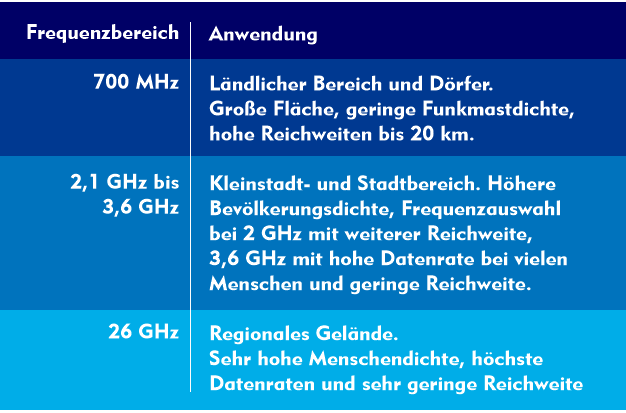5G frequencies
There is a crucial difference between the classic mobile networks of the first generations and the 5th generation mobile network( 5G): While the classic mobile networks are designed for one frequency range, the 5th generation mobile network uses several transmission frequencies, depending on the population density and the distances that can be covered.
5G mobile networks support frequencies between 410 MHz and 52.6 GHz. The 3rd Generation Partnership Project( 3GPP) divides this frequency range into two distinct frequency ranges(FRs), which it labels FR1 and FR2. Accordingly, FR1 ranges from 410 MHz to 7.125 GHz and FR2 from 24.5 GHz to 52.6 GHz. Different transmission bandwidths are available in these frequency ranges. Different countries use different frequencies. For example, Germany uses frequencies at 700 MHz, the microwave range at 2.1 GHz and 3.6 GHz, and SHF frequencies of 26 GHz. The 700 MHz frequencies resulting from the digital dividend are suitable for area propagation with low population density. In the 700 MHz range, the frequencies from 703 MHz to 733 MHz and from 758 MHz to 788 MHz are used. The aim is to cover as large an area and as many villages as possible with just a few cell towers. The achievable ranges can be up to 20 km, depending on the landscape topology. The bandwidths for 700 MHz transmission allow only limited data rates.
In general, the propagation of electromagnetic waves is limited by free- space attenuation, which has a strong frequency dependence. At 700 MHz and a distance of 100 m, it is about 70 dB, and at a distance of 1 km, the value increases by another 20 dB. To be able to serve a higher density of mobile devices with higher data rates in small towns, frequencies of 2.1 GHz are therefore used in this range. The 2.1 GHz frequency range is shared by the 5G providers Vodafone, O2 Telefonica, Drillisch and Deutsche Telekom. The uplinkfrequencies are between 1.92 GHz and 1.98 GHz, the downlink frequencies between 2.11 GHz and 2.17 GHz. In this frequency range, the bridgeable distances are shorter than at 700 MHz because the free-space attenuation is much higher. At 100 m, it is already around 80 dB.
In terms of large cities, 5G mobile services focus on high population density and high data rates. Both characteristic values can be realized with transmission frequencies of 3.4 GHz to 3.7 GHz. The small distances that can be bridged play a subordinate role here. In order to be able to serve concentrated gatherings of people, such as those in stadiums, train stations, airports and exhibition centers, with mobile communications, 5G will also transmit in the millimeter-wave range at 26 GHz. In Europe, the frequency range between 24.25 GHz and 27.5 GHz is earmarked for this purpose. This makes it possible for thousands and thousands of 5G mobile subscribers to communicate simultaneously. As far as free-space attenuation in this frequency range is concerned, it is 80 dB at 10 m, 87 dB at 20 m and 100 dB at 100 m.

